Kohl Construction, doing business as Tofino Associates and Northern Avenue Homes, submitted a stormwater drainage report today to the Conservation Commission along with its revised proposal for condos off North Street. The configuration of units is the same as presented to the Commission on February 26 (23 units plus roads and parking lots). As we’ve mentioned before, this parcel of land reported flood damage from Tropical Storm Floyd in 1999, and that’s before Kohl cuts down any water-absorbing trees or adds over an acre of impervious surface to the site.
The Conservation Commission will review this latest submission at its March 12 meeting, 6:15pm in the City Hall Hearing Room, 2nd floor (enter via the back door). Concerned citizens are urged to attend.
Here are the documents Kohl submitted today:
Letter to Conservation Commission, 3/6/09: Introduction and Brief from Attorney Michael Pill (PDF, 192KB)
Stormwater Drainage Report Summary (PDF, 594KB)
Stormwater Drainage Report – Main Body (PDF, 2.8MB)
Notice of Intent Plans for North Street Condominiums (oversize charts) (PDF, 10.2MB)
Here are new documents submitted by Kohl during the week of March 9:
Draft Restrictions and Covenants (PDF, 38KB)
Cold Spring Environmental Consultants re: Effects of Norway Spruce Removal on Hydrogeology (PDF, 42KB)
See Jono Neiger’s contentions about these effects and our further research.
Letter to Conservation Commission, 3/9/09: LEC Presents What Kohl Would Do to Improve the Wetland and Buffer Zone (3.7MB)
LEC neglects to address the impact of tree removal on Kohl’s land, which could be substantial.
Cold Spring Environmental Consultants: Test Pit & Soil Evaluation Results, Letter of 3/10/09 (PDF, 735KB)
Stormwater Drainage Report Supplemental Summary dated 3/11/09 (PDF, 18KB)
Rain Garden Revision dated 3/11/09, Plan View (PDF, 197KB)
Rain Garden Revision dated 3/11/09, Detail View (PDF, 117KB)
Test Pit Locations, Revision of 3/11/09 Showing Seasonal High Groundwater (PDF, 1.7MB)
Berkshire Design Group Recharge Calculations of 3/10/09 (PDF, 2.9MB)
Only 42.4% of the runoff from the 47,959 square feet of new impervious area in this development would be sent to the infiltration system. This is the “maximum extent practicable” due to “high groundwater and hydrologic group ‘C’ soils throughout the site”. (page 5)
Here is the text from the 3/6/09 Letter to the Conservation Commission:
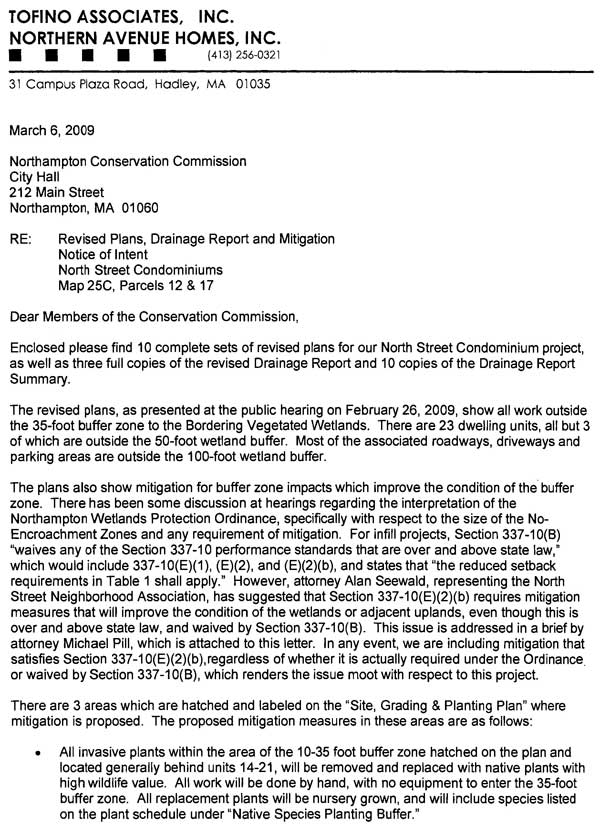
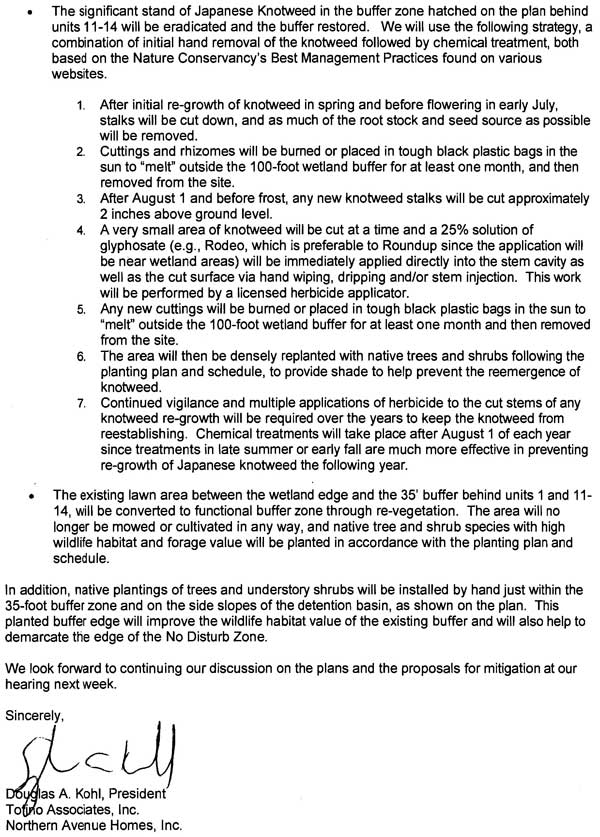
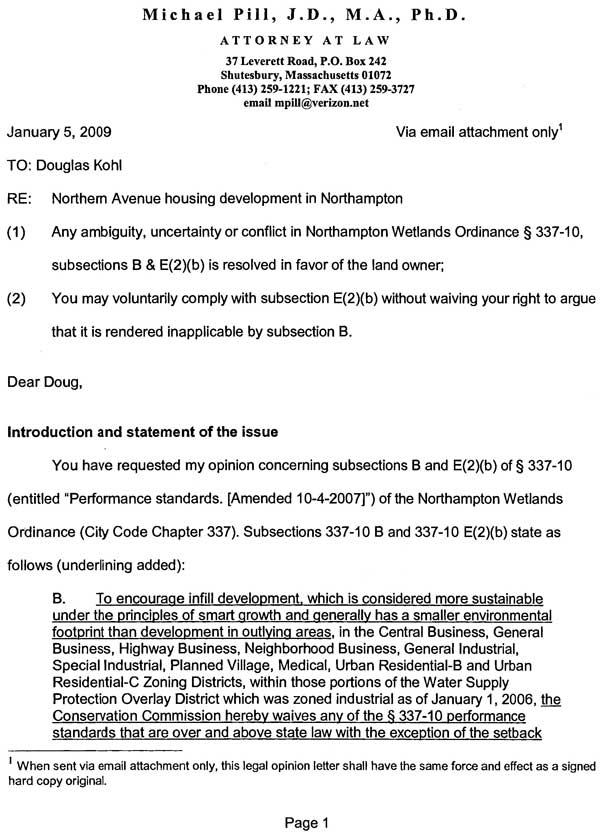
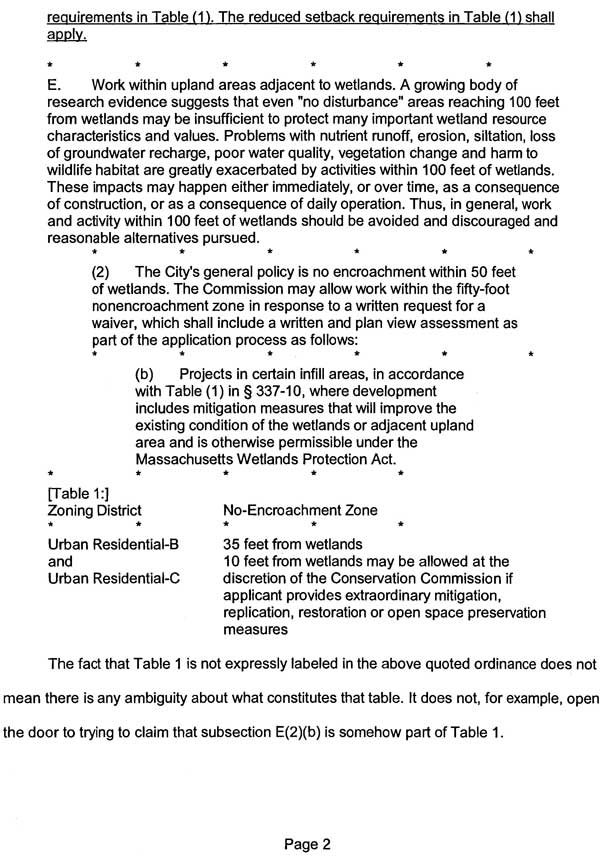
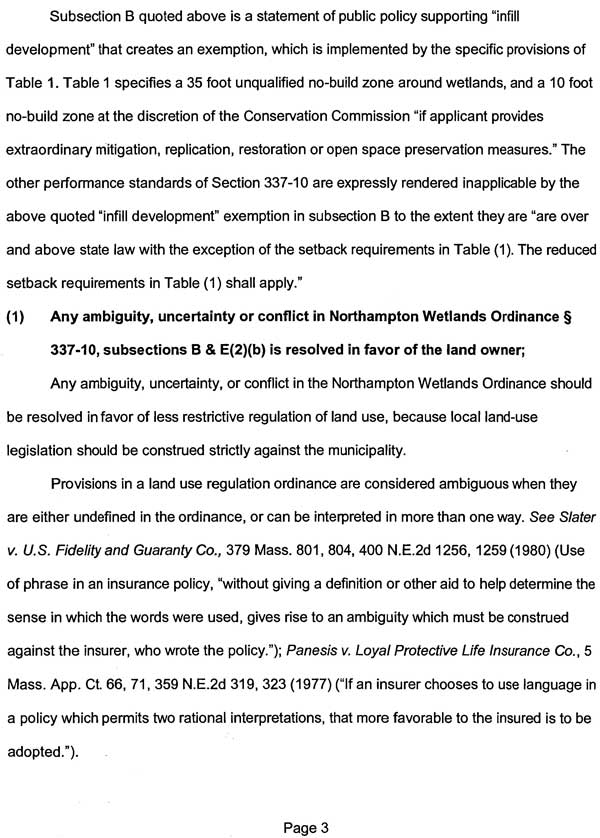
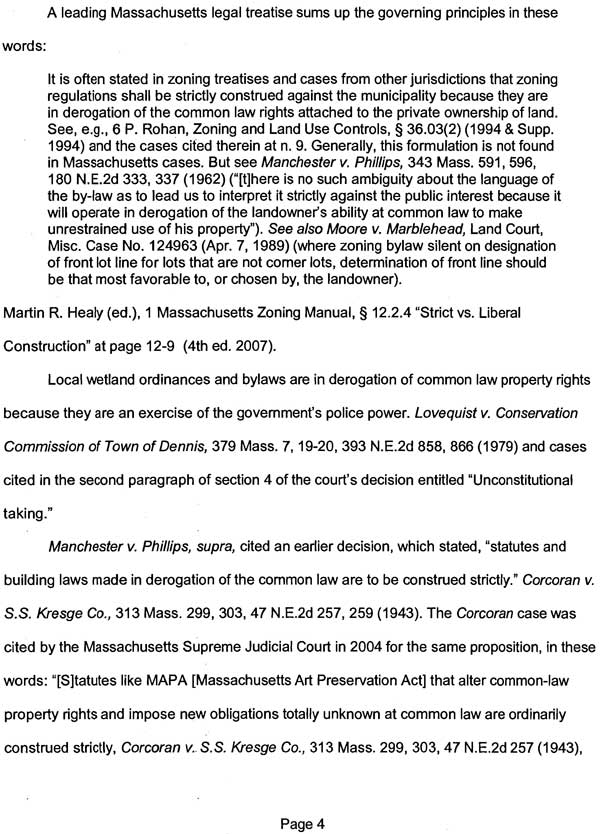
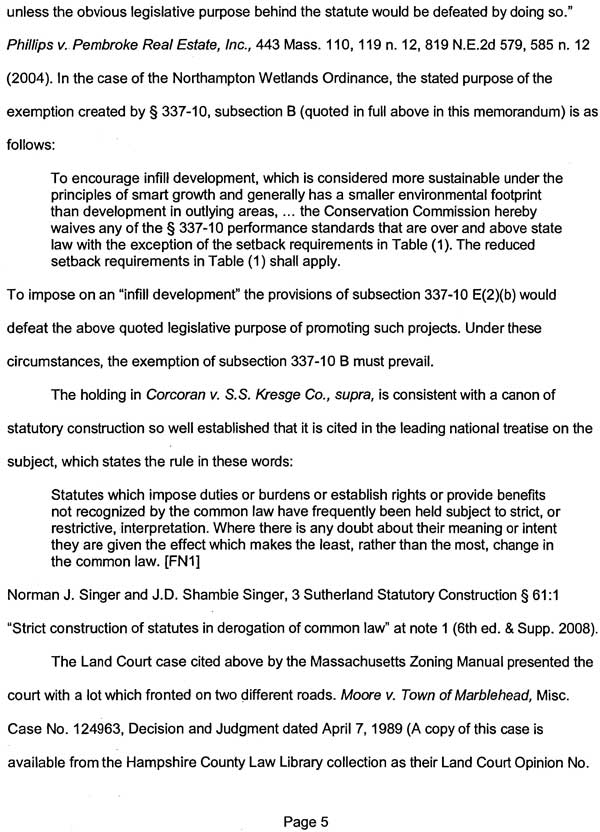
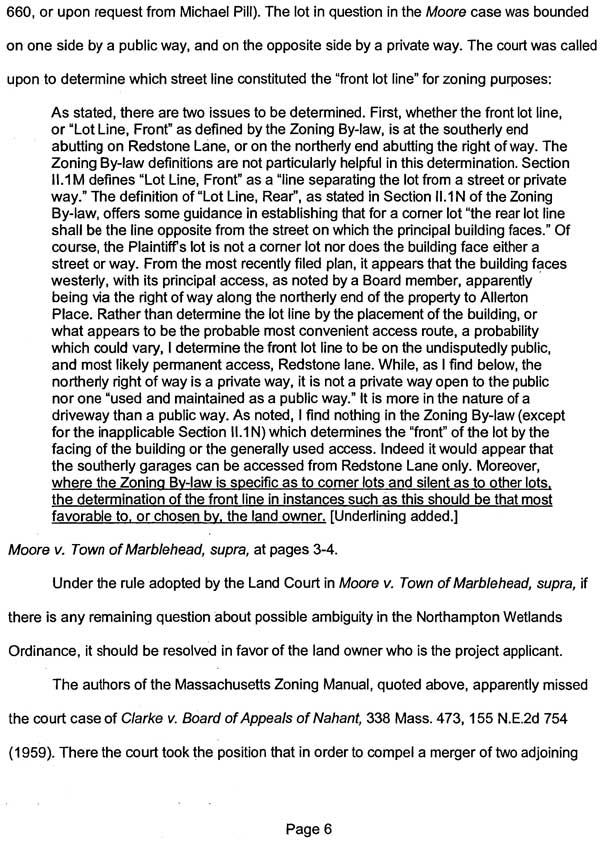
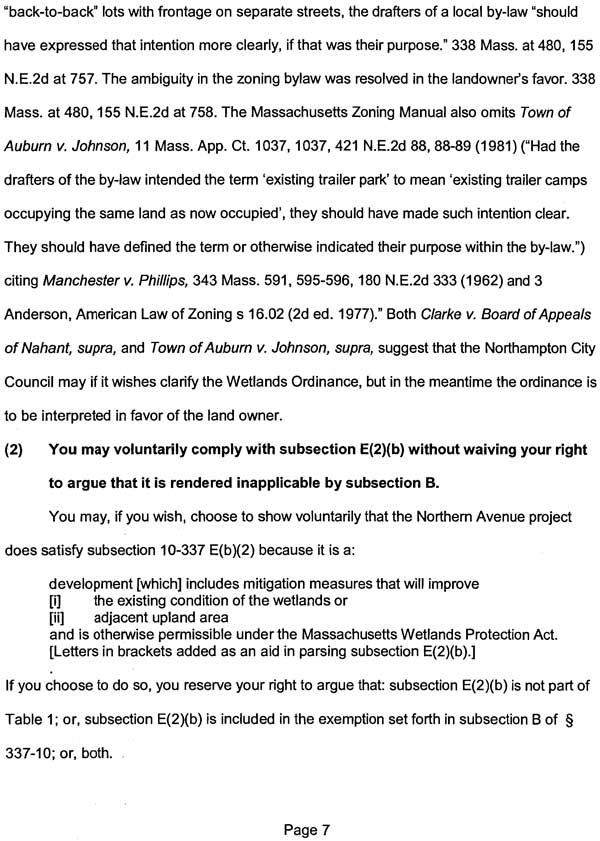
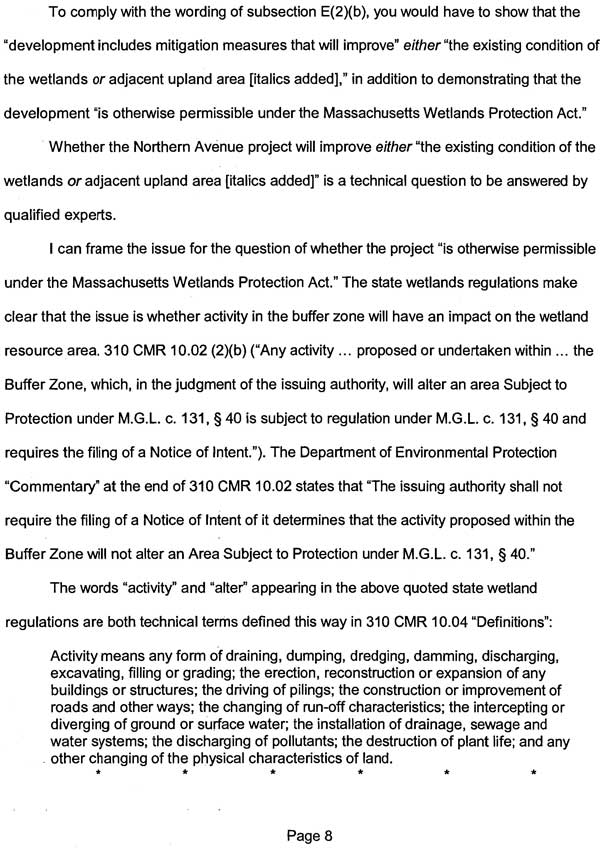
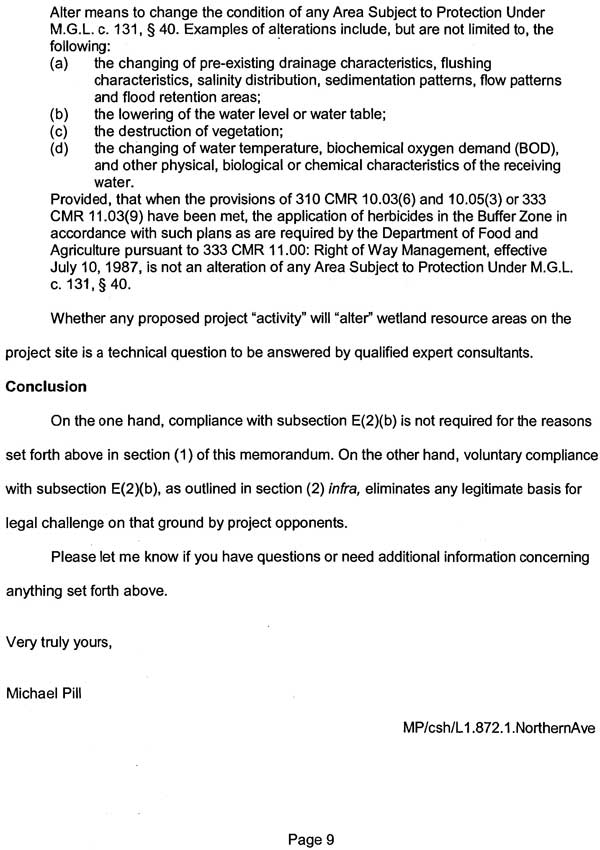
In the brief above, Attorney Pill leans hard on promotion of infill in justifying his interpretation of the Wetlands Ordinance. Here is how the Notre Dame School of Architecture defines “infill” in Envisioning Sustainable Northampton:
“Infill: noun – new development on land that had been previously developed, including most greyfield and brownfield sites and cleared land within urbanized area. verb- to develop such areas.” (page G3)
This definition is not a good fit with most of Kohl’s land off North Street. This land is largely undeveloped and uncleared, and currently contains just one single-family house (8 View Avenue). It also contains one of downtown’s few remaining groves of mature trees and buffers a wetland. Responsible–sustainable–infill should not be interpreted as a license to pave over a city’s green infrastructure.
Below is a special area of concern in Kohl’s proposal. Test pit data suggests the bottom of the detention basin on the left is less than two feet from seasonal high groundwater. Water may stagnate in this basin with a risk of poor stormwater management and mosquito problems. On the right is an underground stormwater detention system. Underground detention basins were recently found to be failing at Bridge Street School and will be bypassed at a cost of $22,000.
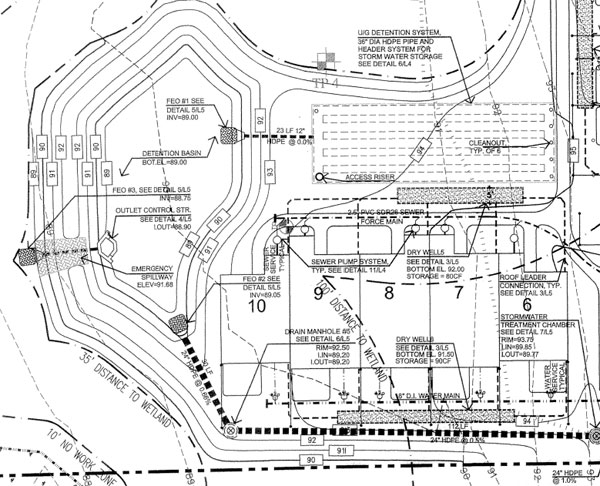
See also:
Comparing the New Hazards Mitigation Plan to the Old One: Wetlands Protection Weakened
“The last hurricane to make landfall in New England was Hurricane Floyd,
a weak category 2 hurricane, in November 1999. Therefore, it is
forecasted that, Massachusetts, and the rest of New England, is
long overdue for a major hurricane to make landfall. Based on past
hurricane and tropical storm landfalls, the frequency of tropical
systems to hit the Massachusetts coastline is an average of once out of
every six years.” (p.28, emphasis added)
Hyla Ecological Services Analyzes the Proposed Wetlands Ordinance
The criterion: “Projects in certain infill areas” is vague and would be
open to much debate. Neither the term “infill” nor the more specific
phrase “certain infill areas” are defined in the proposed Ordinance.
The word “infill” is of rather recent and specialized derivation, and
generally unfamiliar. Definitions of “infill” available on the Internet
vary widely. If this term is to serve as a meaningful condition by
which projects might qualify for reduced non-encroachment zone widths,
it must be tightly defined, ideally through reference to a mapped
overlay. As currently drafted, the phrase invites applicants to argue
that their particular lot is “infill” since there are other developed
lots nearby, an argument that could presumably be applied to almost any
site in Northampton…
Northampton Redoubt: Urban Ecology, Planting Trees, and the Long-Term View
If we remove all of our in-town forested areas and wetlands
they will likely be gone forever or at least a very long time. We would
do well for posterity to err on the side of caution. For
example the cost estimate to restore part of the downtown historic Mill
River channel runs into the millions of dollars. Had the river’s
diversion in the 1940s been handled differently, perhaps with a sharper
eye towards the future, maybe today we wouldn’t be searching for
dollars to make its restoration a reality…
…People may
disagree as to the importance of our own urban ecology, but I
have yet to read anywhere where infill is described as developing
existing and vital ecosystems. Each time I read about infill the topics
concern redeveloping brownfields or previously developed urban areas
that are not utilized to the fullest extent.
Japanese Knotweed and Multiflora Rose: Is Herbicide the Answer?
[Japanese knotweed:] “Once established, F. japonica is very difficult to eradicate and removal efforts may have further adverse impacts on the soil or other plants…”
[Multiflora rose:] “Where plants have become well established, a huge seed bank develops
that can continue to produce seedlings for at least twenty years after
removal of mature plants…”
Based on the longevity of the seed bank, eradication might be a 20-year
project or more…
It seems unreasonable and unrealistic to ask a developer and the
Conservation Commission to implement and monitor such a lengthy
program, especially when non-compliance with wetlands agreements has proven to be a widespread problem in Northampton.
In
contrast to a relatively short program of toxic
herbicides–extraordinary or not–the long-term, low-risk,
environmentally gentle solution to these invasive species appears to be
bringing the ecology back into balance, allowing and in some cases
encouraging the natural predators of knotweed and multiflora rose to
feast on their abundance. Additionally, preserving mature trees will
help control knotweed.
Herbicide Caution: Glyphosate Use May Damage Woody Plants
“Glyphosate should not be used to remove suckers, there should be a
30-foot buffer between the weeds you are spraying and the woody plants,
and glyphosate should not be applied so frequently,” said [Hannah Mathers, an Ohio State University Extension nursery and
landscape specialist].
Glyphosate Factsheet: Unwanted Impacts
Video: Kohl Presents Revised Proposal to Conservation Commission on February 26
The removal of the Spruce could have a significant effect on the water
table. It is estimated that the wooded area to be cleared pumps out
410,000 gallons of water a year out of the water table. This is equal
to 1.25 feet of water per year which could translate to a water table
elevation of 2.5-3.4 ft depending on soil porosity and hydrological
dynamics.
Planning Board Gives Initial Critique of Kohl Condo Proposal: Jan 22 Video
1:09:30… Doug Kohl of Kohl Construction: “I could see that
making little single-family houses is more in keeping with the
footprint of this neighborhood.”
1:37:00… Planning Board chair Francis Johnson: “I think there’s a concern about the number of units…”
1:37:07… Planning Board member George Kohout:
“…perhaps this development is a little too dense for a number of
reasons. Just that it does create a different kind of burden on a
neighborhood–not quite in character…and that’s one of our big
criteria in this kind of review. It would also relax part of the stress
on wetlands by moving, let’s just say, for example, those four units,
22, 23, 24 and 25, out of there. That might allow for some different
configuration of the stormwater structures and provide more room for
some of that shared access. But I’m also struck by the offer that the
developer made about looking at single-family homes… workforce
housing…because single-unit structures would fit in much more with
this area.”
1:47:48… Doug Kohl: “You will get as part
of that [forthcoming additional test pit data], questions addressed
like, ‘Is any portion of the building that we’re placing here built in
any kind of a previously filled wetlands?’ We should be able to answer
that question for you quite clearly.”
Gazette Reports on January 22 Kohl Condo Hearings; Pictures of the Latest Proposal; Conservation Staff Report; HYLA Critique
[Dr. Bryan Windmiller:] …the applicant proposes to mitigate the impacts of buffer zone
disturbance by disturbing even more area of inner buffer zone… This mitigation effort will, in fact, only
worsen the impacts to the wetlands bordering Millyard Brook…
The intended use of herbicides by the applicant to control Japanese knotweed (Polygonum cuspidatum)
will moreover result in the pollution of the wetland with herbicides
and their toxic surfactant agents. The commonly used herbicide
glyphosate (Rodeo and Roundup) has been shown to be highly toxic to
amphibians, for example, in numerous papers by Rick Relyea and
colleagues (see summary at: http://www.medicalnewstoday.com/articles/22159.php). Japanese knotweed and multiflora rose (Rosa multiflora)
are furthermore difficult to eradicate, even with herbicides. To do so
will require significant doses of herbicide applied many times.
In
the end, such schemes are likely only to result in further degradation
of the wetland system. How long will the applicant continue to remove
exotic species and replace dead shrubs and trees that are planted in
the mitigation areas? Three years? Five? Ten?
Video of December 11 Kohl Condo Hearing at Conservation Commission; Hearing Continued to January 8
Kohl Construction Applies for Special Permit and Site Plan Review
Video: School Committee Meeting of December 11; Regionalization Discussed
Funding Approved for Bridge Street School to Address Flooding
Problems: Process Stormwater with Sewer Tie-in Rather Than Detention
Basins
1:42:55-1:43:33
“Bridge Street School has an issue
with flooding because of the detention basins which are underground
there. And every time we get a downpour we have issues of flooding in
the cafeteria and then up that hallway. This will help tie into the
city system, rather than have the water go into these detention basins
which are supposed to then have the water percolate down into the
groundwater. So this will be a major improvement for Bridge Street
School.”
City of Northampton, Memo from Mayor Clare Higgins to City
Councilors, “FY 2009 Capital Improvements Program Recommendations”
(12/4/08)
Bridge Street School – Detention Basin/Sewer Tie-in – $22,000
Repairing the three dry wells at Bridge Street School was ranked as the
[Northampton Public Schools’] second highest priority. The wells are
filled with silt and the ground water backs up into the building. The
DPW has cleaned the wells but the problem still exists due to the lack
of slope and the deteriorated condition of the wells.
EPA: Wetlands and Flood Protection
Wetlands
within and downstream of urban areas are particularly valuable,
counteracting the greatly increased rate and volume of surface-water
runoff from pavement and buildings…
A one-acre wetland can
typically store about three-acre feet of water, or one million gallons.
An acre-foot is one acre of land, about three-quarters the size of a
football field, covered one foot deep in water. Three acre-feet
describes the same area of land covered by three feet of water. Trees
and other wetland vegetation help slow the speed of flood waters. This
action, combined with water storage, can actually lower flood heights
and reduce the water’s destructive potential. (Source: EPA)